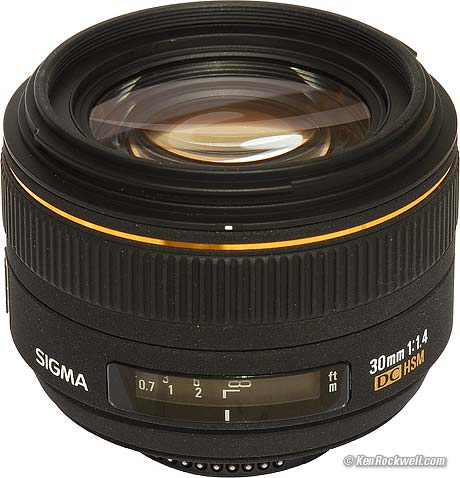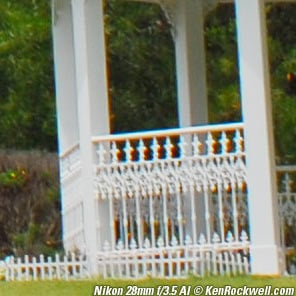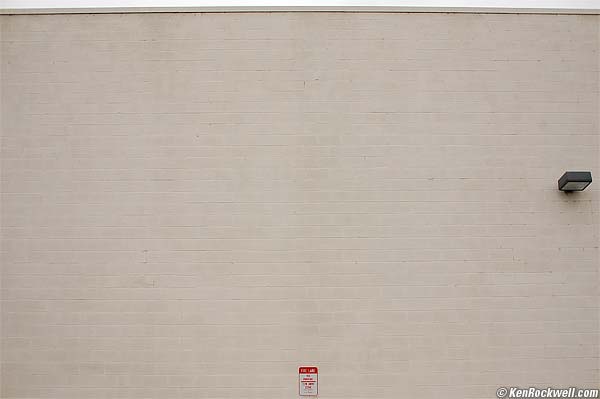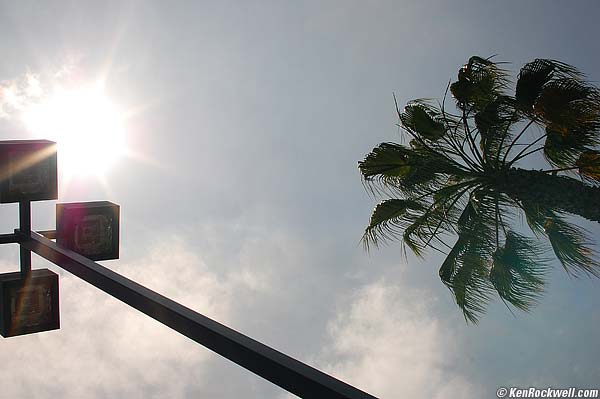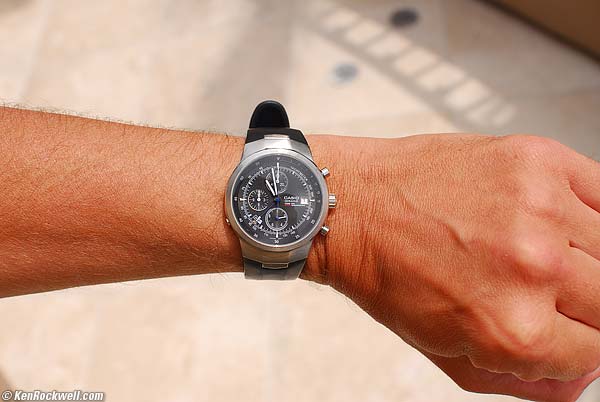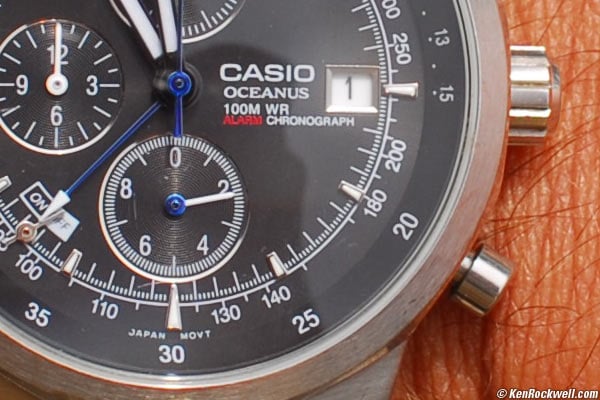Home New Search Gallery How-To Books Links Workshops About Contact
Sigma 30mm f/1.4
© 2007 KenRockwell.com
Sigma 30mm f/1.4.
I got this one here. You also can get it here. It helps me keep adding to this site when you get yours from those links, too.
June 2007 More Nikon Lens Tests More Canon Lens Tests.
Top Specs Performance Recommendations
|
I personally buy from Adorama, Amazon, Ritz, B&H, Calumet and J&R. I can't vouch for ads below.
|
The Sigma 30mm f/1.4 is a special-purpose, fast, fixed normal focal length lens for small-format digital SLRs. It sells for about $420.
This Sigma lens works well when used as intended for hand-held shots in dim light. It's lightweight and works fast and easy, especially with the Nikon D40 and D40x, except that it doesn't focus very well or accurately.
If you shoot Canon, forget this Sigma and get the superior Canon 28mm f/1.8 EF for less money.
If you shoot Nikon, forget this dumpily-made Sigma and get the newest Nikon 35mm f/1.8 for half the price.
You may consider the rest of this review as an historical artifact from the good old first days of digital SLRs.
If you need a full f/1.4 in a normal focal length for a small-format digital camera, can work around some repeatable autofocus inaccuracy and want to spend about $400, this is your lens.
It comes in versions to fit Canon, Nikon, 4/3 system (Olympus, Panasonic), Pentax KAF, Samsung, Minolta A AF, Sony A and Sigma cameras. I tried the version for Nikon. I presume the others are optically identical.
This Sigma 30mm f/1.4 lens gives the same angle of view, and somewhat greater depth-of-field at the same aperture, as a 50mm lens does on a film camera.
No other maker makes anything identical to a 30mm f/1.4 for under $1,000. If you need f/1.4 in a lens of this focal range for under a thousand dollars, this is it.
If you have a Nikon D40 or D40x, this also is your lens because Nikon makes no lenses faster than f/2.8 which autofocus with a D40/x.
If you're not using a D40 or D40x, if f/1.8 or f/2 is fast enough in this focal length, or if 50mm (80mm equivalent) is OK, you can pay less and get genuine Canon or Nikon lenses instead. I'll cover this later at recommendations.
The Sigma 30mm f/1.4 is not a wide-angle and it doesn't work on film, FX or full-frame cameras. I tried it, and the corners go black on full-frame. It easily covers 1.6x format Canon and Nikons. It might even cover 1.3x Canons like the 1D series, but I didn't try it. It's not rated to work with 1.3x cameras, so good luck.
Good News:
1.) A unique lens that works and handles well. It doesn't get in the way.
2.) Lightweight.
3.) Fast and easy AF, especially with Nikon D40 and D40x.
4.) Just grab the focus ring, even in AF mode, for instant manual focus override with no need to move any switches.
Bad News:
1.) Design flaw causes the manual focus confirmation light in my Nikons not to work properly during manual focus override. Furthermore, another defect causes my cameras to ignore my manual focus override in AF-C mode and revert to autofocus. These can be worked around by manually setting my Nikons to manual focus, which eliminates some of the usefulness of instant manual focus override.
2.) AF often focused slightly in front of my subject with my D200, potentially significant at the large apertures for which you buy this lens. I worked around this by pointing my AF sensors at something behind my subject if it was critical. This isn't a problem for real, live 3D subjects. This effect varies from sample to sample and camera to camera. It was fine on my D40.
3.). AF didn't focus beyond about 50' (20m) on my D200. I worked around this by setting focus manually using the accurate infinity mark on the focus scale. It was fine on my D40.
4.) Miscalibrated diaphragm lead to overexposed images. I worked around this by setting exposure compensation to -0.7 more than what I would use with other lenses.
5.) Single purpose: It doesn't zoom, and doesn't focus very close.
6.) Dinky-feeling plastic and rough manual focus feel.
7.) No infinity stop for astronomical use, but infinity mark was accurate.
8.) Optics not up to astronomical use, and not as sharp at smaller apertures as other slower lenses.
SPECIFICATIONS with commentary
Top Introduction Performance Recommendations
Name: Sigma calls this the 30mm F1.4 EX DC HSM.
EX: "EXpensive." More expensive than other Sigma lenses.
HSM: "Hyper-Sonic Motor:" Quiet focusing and instant manual focus override. Same idea as Nikon AF-s SWM and Canon EF USM.
DC: "Digitally Crippled." Only works on 1.6x Canon or Nikon digital cameras, not film or 1.3x or full-frame digital. It also comes in mounts for Olympus 4/3 and Sigma cameras.
Focal Length: 30mm. Used on a Nikon digital camera it gives an angle of view similar to what a 46mm lens would give on a 35mm film camera. On a Canon 1.6x camera it gives an angle of view similar to what a 49mm lens would give on a 35mm film camera. See also Crop Factor.
Maximum Aperture: f/1.4
Optics: 7 elements, 7 groups, including one SLD and one ELD glass element (same idea as Nikon's ED or Canon's UD) and one molded glass aspherical element. This magic glass is supposed to help reduce color fringing, while the aspherical element ought to help reduce coma and spherical aberration at f/1.4. In practice this Sigma has more color fringing and is fuzzier in the corners than my Nikon 18-200mm zoom, oh well.
Diaphragm: 8 blade octagonal, stopping down to f/16.
Filter Size: 62 mm.
Close Focus: 1.25' or 0.40 m from the image plane (the back of the camera), rated. This isn't very close. All the similar Canon and Nikon lenses focus much closer. I see no mention of close-range correction or floating elements, which is most likely why it only focuses as close as a foot and a half.
Maximum Reproduction Ratio: 1:10.4, not very close.
Infrared Focus Index? No, unfortunately.
Size: 3.0" diameter x 2.3" extension from flange (76.6 x 59mm), rated.
Weight: 14.345oz. (406.7 g), measured, naked.
Hood: included.
Case: nice padded Cordura-style case included.
Top Introduction Specs Recommendations
Autofocus Bokeh Color Color Fringes Construction
Distortion Ergonomics Exposure Falloff Film Filters
Flare Macro Serial Number Sharpness Sunstars
It works well for its intended purpose: low-light hand-held shooting. Optically it's not as good for shooting test charts as the Canon or Nikon f/1.4 lenses that cost several times as much, but this is irrelevant because of the tiny depth of field at f/1.4 for photographing real things.
FOCUSING back to Performance or back to Introduction.
Focusing works great, one of the advantages of the Sigma 30mm f/1.4. Unlike my Nikon 28mm f/1.4, just grab the focus ring at any time for manual focus, no switches required. Unlike the Sigma 10-22mm which didn't always focus well with other than the central AF sensor of my D200, this 30mm f/1.4 focuses fine with all my AF sensors.
Autofocus Accuracy
AF accuracy is fine for the things I would shoot with this lens, like people and kids in dim light.
The Sigma 30mm f/1.4 is very bad, depending on your camera, for photographing at long distances. The AF system, at least on my D200 at f/1.4 and large apertures, consistently wouldn't focus at infinity and instead focused too closely. I focused by scale instead for objects further away than about 50 feet (20m). If this is a lot of what you do, you probably won't be happy with this lens. It was perfect with my D40. This will vary from sample to sample and camera to camera.
AF accuracy is always a problem for shooting test charts with f/1.4 lenses. This has driven me crazy since the 1970s. For hand-held shots in dim light of wiggly subjects (the whole point of this lens) the AF accuracy is fine. For shooting flat test charts it's poor, but no one buys this lens for shooting test charts. For test charts and astronomical use, get the discontinued Nikon 28mm f/1.4 AF or the insanely good new Canon 85mm f/1.2L II.
At f/1.4 this is obvious if you're dumb enough to be shooting at f/1.4 in daylight. In real use it's invisible at f/4, and in the dark it's not much of an issue since most things worth shooting are deeper than the depth of field anyway. If you worry about these issues, don't get this lens, or at least try a different sample.
Ryan on his changing table. (D40, Sigma 30mm, f/1.4 at 1/30, Auto ISO chose ISO 1,600, cropped to about 50% of the image.)
This shot is typical: focus is fine for the real things where one needs f/1.4 in dim light. Notice how his hand is completely out of focus due to no depth of field. This sort of shot is why you get this lens, and for this stuff, this lens is great. In the full size image (not shown) his face, eyes and texture of the fabric in his shirt look great. Remember, this kid never holds still, so you can't focus manually on him or use a slower lens in the light I had.
Here are more practical examples. In each case, focus is fine.

Palm Tree. (D200, Sigma 30mm, f/1.4 at 1/8 hand-held, Auto ISO chose ISO 1,600, full image.)
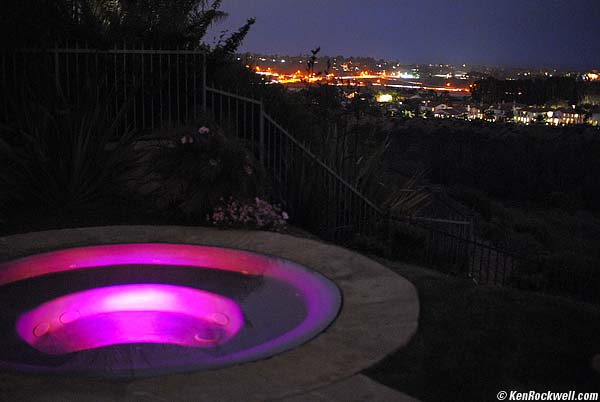
Spa on the Moon. (D200, Sigma 30mm, f/1.4 at 1/2 second hand-held, Auto ISO chose ISO 1,600, full image. Autofocused at close to infinity; spa is out of focus.)
What Moves When Focusing
The optical tube inside the mount moves in and out. The filter ring and the externals of the lens don't move.
Focus Distance Scale
Meters and feet, crammed together and the same color. Good luck figuring out which is which.
Depth of Field Scale
NONE, too bad since it would make sense on a fixed focal length lens.
Speed
AF speed is fast. This is rarely an issue for short focal length lenses.
Ease of Manual Focusing
Excellent: just grab the focus ring at any time for instant manual focus override. You don't need to move any switches.
Like other Sigma lenses, it feels gritty and cheap. It doesn't have the smooth, precise feel of a Canon or Nikon lens.
Unlike a real Nikon lens, Sigma is a third-party unauthorized (by Nikon) attachment. You always run the risk of having some advanced features not work. Nikon does not share its proprietary operating information with anyone, so third party lenses may and may not work correctly. This is even worse as you buy newer cameras, because Nikon lenses today already incorporate compatibility with Nikon cameras of tomorrow about which Nikon is telling no one. Did you notice recently how all Nikon's new lenses for the past few years have been AFS, so that they work on the D40 introduced only in December 2006, effectively skunking Tokina who make no lenses which will autofocus on the D40?
The problem I discovered with the Sigma 30mm f/1.4 is that my Nikons' focus confirmation lights, critical for manual focusing, don't work properly unless you deliberately put the camera into the manual focus mode. This negates much of the magic of having instant manual focus override, since you may not have enough precision using only the ground glass to focus at f/1.4. (The ground glass only shows the view at about f/2.8, not at f/1.4.)
Nikon lenses work correctly, which means that any time you grab the manual focus ring with the shutter pressed halfway, even with the camera left in autofocus mode, the focus confirmation light works properly. With this Sigma lens, the light locks up in either on or off, wherever it was when you grabbed the ring.
Creepier, after you've grabbed the manual focus ring in AF-C (continuous) mode, the Sigma will revert to AF mode instead of locking the manual focus properly.
Correct operation, which is what you get with real Nikon lenses, is that even if you're in AF-C mode and grab the manual focus ring that the focus stays set where you put it until you release and retap the shutter buton halfway.
This gets worse on my D40, since my D40 has no external AF/MF switch. On the D40 I need to go into a menu to select manual focus, and to select between single (S) or continuous (C) or automatic selection (AF-A) AF modes. Therefore, when I grab the manual focus ring on my D40 in the D40's default AF-A mode, if the subject is not moving I can set focus manually (still without a focus confirmation light) on the Sigma 30mm f/1.4. Heaven help me if the D40 thinks the subject is in motion, because the D40 will automatically be tracking the subject. Now if I grab the Sigma's manual focus ring, I'll get manual focus for a moment, and then the D40 will take over again and continue to autofocus.
These issues are subtle, but potentially disturbing. You may not notice them until after you've owned the Sigma for a while, and I can imagine people sending things back wanting these issues repaired. Fat chance; these sorts of annoying missed details are why I prefer not to use anything other than a lens of the same brand as my camera.
Focus Breathing
Breathing is a motion picture term which refers to what happens as you pull (change) focus from near to far. I list this for people putting these lenses on their Canon XL-1s for shooting video.
It has a little bit of the usual focus breathing to be expected for a lens which focuses by the traditional racking in and out.BOKEH back to Performance or back to Introduction.
Bokeh is nice! Out-of-focus backgrounds get soft and don't distract.
Typical for lenses with aspherical elements, out of focus points of light in the corners can acquire bizarre shapes. The Sigma 30mm f/1.4 usually renders points of light behind the subject in the far corners as a cross between a U and a V. This isn't that important.
The bokeh of the Sigma 30mm f/1.4 is a nice, natural softness. I like it.
COLOR FRINGES
(Lateral Chromatic Aberration or LCA)
back to Performance or back to Introduction.
The Sigma 30mm f/1.4 is ordinary. It's about the same as the exotic Nikon 28mm f/1.4 AF, but not as good as today's Nikon 18-200mm VR. All of these are better than the 1980-vintage Nikon 28mm f/3.5 AI manual focus lens I threw in for fun, but then again, I only paid $35 for the old AI lens in perfect condition.
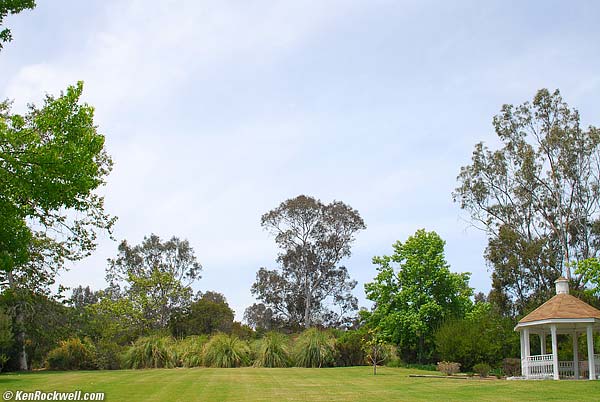 |
Full Image. The crops below are taken from this image at 100% |
|
|
COLOR RENDITION back to Performance or back to Introduction.
I see no difference from my other Nikon lenses. Any visible differences below come from exposure variations, not color transmission or coatings.
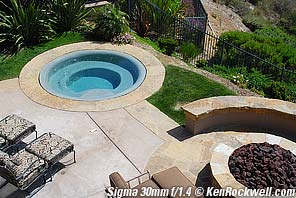 |
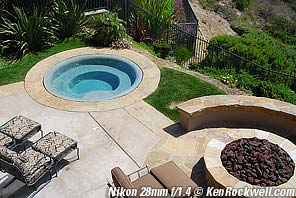 |
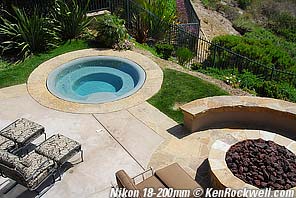 |
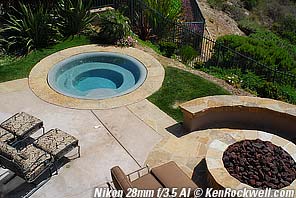 |
back to Performance or back to Introduction.
This is my biggest whine with Sigma lenses. Their construction quality doesn't breed confidence. I doubt these Sigma lenses will ever wind up in collectors' cases.
Exterior: Metal and Plastic, all painted with a dopey soft dull black paint with subtle sparkles in it. I prefer the black enamel of classic Nikkors.
Filter Threads: Plastic.
Focus Ring: Ribbed rubber set in hard plastic.
Markings: Paint.
Switches: None.
Mount: Metal.
Internals: Plastic and metal, hard to tell.
Diaphragm: Not even. One side of the octagon sticks out further than the others, and overall it gives about a half stop overexposure.
Noises when shaken: Just a little bit of clinking, much less than zoom lenses. This is normal.
Made in: Japan.
DISTORTION back to Performance or back to Introduction.
Distortion is a little more than I was hoping, but about right for this sort of lens. Distortion shouldn't matter for the dimly lit subjects I'd be shooting with a lens like this.
Plug +2.0 into Photoshop CS2's lens distortion filter to correct the distortion. It doesn't correct perfectly, but so what, you shouldn't be shooting brick walls anyway. My $35 Nikon 28mm f/3.5 AI is better for distortion, but so what: the Sigma 30mm f/1.4 isn't for photographing brick walls, and it's trivial to correct in Photoshop CS2 anyway.
Here's the proverbial Bad Photographers' Wall of Shame:
Brick wall. Roll mouse over to see after correction at +2 in Photoshop CS2's lens distortion filter.
ERGONOMICS back to Performance or back to Introduction.
Great! The Sigma 30mm f/1.4 never gets in the way. Just shoot. There are no switches or glitches.
EXPOSURE ACCURACY back to Performance or back to Introduction.
Poor. The mechanical calibration of the diaphragm of the sample of Sigma 30mm f/1.4 I had overexposed by 0.7 stops. No big deal, I simply set -0.7 on my exposure compensation on my D200.
back to Performance or back to Introduction.
Falloff is fine. It's invisible in real shooting.
Here are shots of an Expodisc. Shooting flat fields and laying them on another flat field is a tough test which exaggerates even the slightest falloff. You'll never see it this bad in normal photography.

